Chapter 1:
Introduction ..................................................................................................5
Chapter 2:
Classical Encryption Techniques ...............................................................7
Chapter 3:
Block Ciphers and the Date Encryption Standard ................................13
Chapter 4:
Finite Fields .................................................................................................21
Chapter 5:
Advanced Encryption Standard ..............................................................28
Chapter 6:
More on Symmetric Ciphers ....................................................................33
Chapter 7:
Confidentiality Using Symmetric Encryption .......................................38
Chapter 8:
Introduction to Number Theory ..............................................................42
Chapter 9:
Public-Key Cryptography and RSA ........................................................46
Chapter 10: Key Management; Other Public-Key Cryptosystems ...........................55
Chapter 11: Message Authentication and Hash Functions .......................................59
Chapter 12: Hash and MAC Algorithms .....................................................................62
Chapter 13: Digital Signatures and Authentication Protocols ..................................66
Chapter 14: Authentication Applications ....................................................................71
Chapter 15:
Electronic Mail Security ............................................................................73
Chapter 16:
IP Security ...................................................................................................76
Chapter 17: Web Security ...............................................................................................80
Chapter 18:
Intruders ......................................................................................................83
Chapter 19: Malicious Software ....................................................................................87
Firewalls ......................................................................................................89
Chapter 20:
ANSWERS TO QUESTIONS
1.1 The OSI Security Architecture is a framework that provides a systematic way of defining
the requirements for security and characterizing the approaches to satisfying those
requirements. The document defines security attacks, mechanisms, and services, and the
relationships among these categories.
1.2 Passive attacks have to do with eavesdropping on, or monitoring, transmissions.
Electronic mail, file transfers, and client/server exchanges are examples of
transmissions that can be monitored. Active attacks include the modification of
transmitted data and attempts to gain unauthorized access to computer systems.
1.3 Passive attacks: release of message contents and traffic analysis. Active attacks:
masquerade, replay, modification of messages, and denial of service.
1.4 Authentication: The assurance that the communicating entity is the one that it claims to be.
Access control: The prevention of unauthorized use of a resource (i.e., this service controls
who can have access to a resource, under what conditions access can occur, and what those
accessing the resource are allowed to do).
Data confidentiality: The protection of data from unauthorized disclosure.
Data integrity: The assurance that data received are exactly as sent by an authorized entity
(i.e., contain no modification, insertion, deletion, or replay).
�
Nonrepudiation: Provides protection against denial by one of the entities involved in a
communication of having participated in all or part of the communication.
Availability service: The property of a system or a system resource being accessible and
usable upon demand by an authorized system entity, according to performance
specifications for the system (i.e., a system is available if it provides services according to
the system design whenever users request them).
1.5 See Table 1.3.
-2-
�
1.1
ANSWERS TOPROBLEMS
Traffic
analysis
Release
of
message
contents
Masquerade Replay Modification
of messages
Denial
of
service
Peer entity
authentication
Data origin
authentication
Access control
Confidentiality
Y
Traffic flow
confidentiality
Data integrity
Non-repudiation
Availability
1.2
Encipherment
Digital signature
Access control
Data integrity
Authentication
exchange
Traffic padding
Routing control
Notarization
Y
Y
Y
Y
Y
Y
Y
Traffic
analysis
Release
of
message
contents
Masquerade Replay Modification
of messages
Y
Y
Y
Y
Y
Y
Y
Y
Y
Y
Y
Y
Y
Y
Y
Y
Y
Y
Y
Y
Denial
of
service
Y
Y
Y
CHAPTER 2
CLASSICAL ENCRYPTION TECHNIQUESR
-3-
�
ANSWERS TO QUESTIONS
2.1 Plaintext, encryption algorithm, secret key, ciphertext, decryption algorithm.
2.2 Permutation and substitution.
2.3 One key for symmetric ciphers, two keys for asymmetric ciphers.
2.4 A stream cipher is one that encrypts a digital data stream one bit or one byte at a
time. A block cipher is one in which a block of plaintext is treated as a whole and
used to produce a ciphertext block of equal length.
2.5 Cryptanalysis and brute force.
2.6 Ciphertext only. One possible attack under these circumstances is the brute-force
approach of trying all possible keys. If the key space is very large, this becomes
impractical. Thus, the opponent must rely on an analysis of the ciphertext itself,
generally applying various statistical tests to it. Known plaintext. The analyst may
be able to capture one or more plaintext messages as well as their encryptions.
With this knowledge, the analyst may be able to deduce the key on the basis of the
way in which the known plaintext is transformed. Chosen plaintext. If the analyst
is able to choose the messages to encrypt, the analyst may deliberately pick
patterns that can be expected to reveal the structure of the key.
2.7 An encryption scheme is unconditionally secure if the ciphertext generated by the
scheme does not contain enough information to determine uniquely the
corresponding plaintext, no matter how much ciphertext is available. An
encryption scheme is said to be computationally secure if: (1) the cost of breaking
the cipher exceeds the value of the encrypted information, and (2) the time
required to break the cipher exceeds the useful lifetime of the information.
2.8 The Caesar cipher involves replacing each letter of the alphabet with the letter
standing k places further down the alphabet, for k in the range 1 through 25.
2.9 A monoalphabetic substitution cipher maps a plaintext alphabet to a ciphertext
alphabet, so that each letter of the plaintext alphabet maps to a single unique letter
of the ciphertext alphabet.
2.10 The Playfair algorithm is based on the use of a 5 5 matrix of letters constructed
using a keyword. Plaintext is encrypted two letters at a time using this matrix.
-4-
�
2.11 A polyalphabetic substitution cipher uses a separate monoalphabetic substitution
cipher for each successive letter of plaintext, depending on a key.
2.12 1. There is the practical problem of making large quantities of random keys. Any
heavily used system might require millions of random characters on a regular
basis. Supplying truly random characters in this volume is a significant task.
2. Even more daunting is the problem of key distribution and protection. For every
message to be sent, a key of equal length is needed by both sender and receiver.
Thus, a mammoth key distribution problem exists.
2.13 A transposition cipher involves a permutation of the plaintext letters.
2.14 Steganography involves concealing the existence of a message.
ANSWERS TO PROBLEMS
2.1 a. No. A change in the value of b shifts the relationship between plaintext letters
and ciphertext letters to the left or right uniformly, so that if the mapping is
one-to-one it remains one-to-one.
b. 2, 4, 6, 8, 10, 12, 13, 14, 16, 18, 20, 22, 24. Any value of a larger than 25 is
equivalent to a mod 26.
c. The values of a and 26 must have no common positive integer factor other than
1. This is equivalent to saying that a and 26 are relatively prime, or that the
greatest common divisor of a and 26 is 1. To see this, first note that E(a, p) = E(a,
q) (0 ≤ p ≤ q < 26) if and only if a(p – q) is divisible by 26. 1. Suppose that a and
26 are relatively prime. Then, a(p – q) is not divisible by 26, because there is no
way to reduce the fraction a/26 and (p – q) is less than 26. 2. Suppose that a and
26 have a common factor k > 1. Then E(a, p) = E(a, q), if q = p + m/k ≠ p.
2.2 There are 12 allowable values of a (1, 3, 5, 7, 9, 11, 15, 17, 19, 21, 23, 25). There are 26
allowable values of b, from 0 through 25). Thus the total number of distinct affine
Caesar ciphers is 12 26 = 312.
2.3 Assume that the most frequent plaintext letter is e and the second most frequent
letter is t. Note that the numerical values are e = 4; B = 1; t = 19; U = 20. Then we
have the following equations:
1 = (4a + b) mod 26
20 = (19a + b) mod 26
Thus, 19 = 15a mod 26. By trial and error, we solve: a = 3.
Then 1 = (12 + b) mod 26. By observation, b = 15.
-5-
�
2.4 A good glass in the Bishop's hostel in the Devil's seat—twenty-one degrees and
thirteen minutes—northeast and by north—main branch seventh limb east side—
shoot from the left eye of the death's head— a bee line from the tree through the
shot fifty feet out. (from The Gold Bug, by Edgar Allan Poe)
2.5 a. The first letter t corresponds to A, the second letter h corresponds to B, e is C, s
is D, and so on. Second and subsequent occurrences of a letter in the key
sentence are ignored. The result
ciphertext: SIDKHKDM AF HCRKIABIE SHIMC KD LFEAILA
plaintext: basilisk to leviathan blake is contact
b. It is a monalphabetic cipher and so easily breakable.
c. The last sentence may not contain all the letters of the alphabet. If the first
sentence is used, the second and subsequent sentences may also be used until
all 26 letters are encountered.
2.6 The cipher refers to the words in the page of a book. The first entry, 534, refers to
page 534. The second entry, C2, refers to column two. The remaining numbers are
words in that column. The names DOUGLAS and BIRLSTONE are simply words
that do not appear on that page. Elementary! (from The Valley of Fear, by Sir Arthur
Conan Doyle)
2.7 a.
2
C
B
R
O
U
Y
R
T
U
S
T
4
N
T
B
E
H
I
H
8
R
E
D
M
T
C
E
S
A
T
W
2
E
R
R
A
F
R
L
10
Y
A
P
T
S
E
T
E
R
F
O
8
T
F
O
E
T
O
L
7
P
T
I
H
I
U
O
V
E
U
F
10
W
H
U
T
E
L
E
9
T
T
L
E
D
M
N
E
D
L
R
5
O
E
Y
H
A
T
T
-6-
6
O
H
L
L
E
T
I
N
I
B
I
6
R
H
R
G
T
A
I
3
G
E
A
E
T
H
G
I
S
R
E
3
K
F
T
I
Y
O
N
1
A
T
R
F
H
E
H
F
T
I
N
7
S
T
U
S
R
U
I
4
H
H
F
T
E
A
T
Y
R
N
D
1
C
I
S
R
N
G
B
5
I
I
R
O
L
T
A
O
U
G
S
9
U
N
T
E
D
S
I
�
T
E
T
A
I
D
L
P
H
M
E
T
I
T
D
S
U
C
M
E
O
E
N
T
V
S
E
E
E
A
D
R
U
T
L
F
F
W
R
O
ISRNG BUTLF RRAFR LIDLP FTIYO NVSEE TBEHI HTETA
EYHAT TUCME HRGTA IOENT TUSRU IEADR FOETO LHMET
NTEDS IFWRO HUTEL EITDS
b. The two matrices are used in reverse order. First, the ciphertext is laid out in
columns in the second matrix, taking into account the order dictated by the
second memory word. Then, the contents of the second matrix are read left to
right, top to bottom and laid out in columns in the first matrix, taking into
account the order dictated by the first memory word. The plaintext is then read
left to right, top to bottom.
c. Although this is a weak method, it may have use with time-sensitive
information and an adversary without immediate access to good cryptanalysis
(e.g., tactical use). Plus it doesn't require anything more than paper and pencil,
and can be easily remembered.
2.8 SPUTNIK
2.9 PT BOAT ONE OWE NINE LOST IN ACTION IN BLACKETT STRAIT TWO
MILES SW MERESU COVE X CREW OF TWELVE X REQUEST ANY
INFORMATION
2.10 a.
b.
R
B
G
C
E
D
I/J K M
P
X
U
B
Q
Y
R
D
U
Z
E
F
L
T
Z
L
S
F
N
A
T
H
O
V W
O
N
C
A
G H
I/J K
M
P
V W
S
Y
Q
X
-7-
�
2.11 a. UZTBDLGZPNNWLGTGTUEROVLDBDUHFPERHWQSRZ
b. UZTBDLGZPNNWLGTGTUEROVLDBDUHFPERHWQSRZ
c. A cyclic rotation of rows and/or columns leads to equivalent substitutions. In
this case, the matrix for part a of this problem is obtained from the matrix of
Problem 2.10a, by rotating the columns by one step and the rows by three steps.
2.12 a. 25! 284
b. Given any 5x5 configuration, any of the four row rotations is equivalent, for a
total of five equivalent configurations. For each of these five configurations,
any of the four column rotations is equivalent. So each configuration in fact
represents 25 equivalent configurations. Thus, the total number of unique keys
is 25!/25 = 24!
2.13 A mixed Caesar cipher. The amount of shift is determined by the keyword, which
determines the placement of letters in the matrix.
2.14 a. Difficulties are things that show what men are.
2.15 a. We need an even number of letters, so append a "q" to the end of the message.
b. Irrationally held truths may be more harmful than reasoned errors.
Then convert the letters into the corresponding alphabetic positions:
M
13
P
16
T
20
e
5
l
12
h
8
e
5
a
1
a
1
t m
13
20
c
e
5
3
e
n
14
5
e
5
a
1
i
9
a
1
t
20
g
7
t
20
t
20
h
8
t
20
e
5
t
20
h
8
n
14
o
15
e
5
r
18
c
3
u
21
a
1
l
12
s
19
t
20
o
15
u
21
h
8
c
3
a
1
e
5
k
11
l
12
r
18
q
17
The calculations proceed two letters at a time. The first pair:
The first two ciphertext characters are alphabetic positions 7 and 22, which
correspond to GV. The complete ciphertext:
GVUIGVKODZYPUHEKJHUZWFZFWSJSDZMUDZMYCJQMFWWUQRKR
b. We first perform a matrix inversion. Note that the determinate of the
encryption matrix is (9 7) – (4 5) = 43. Using the matrix inversion formula
from the book:
-8-
�
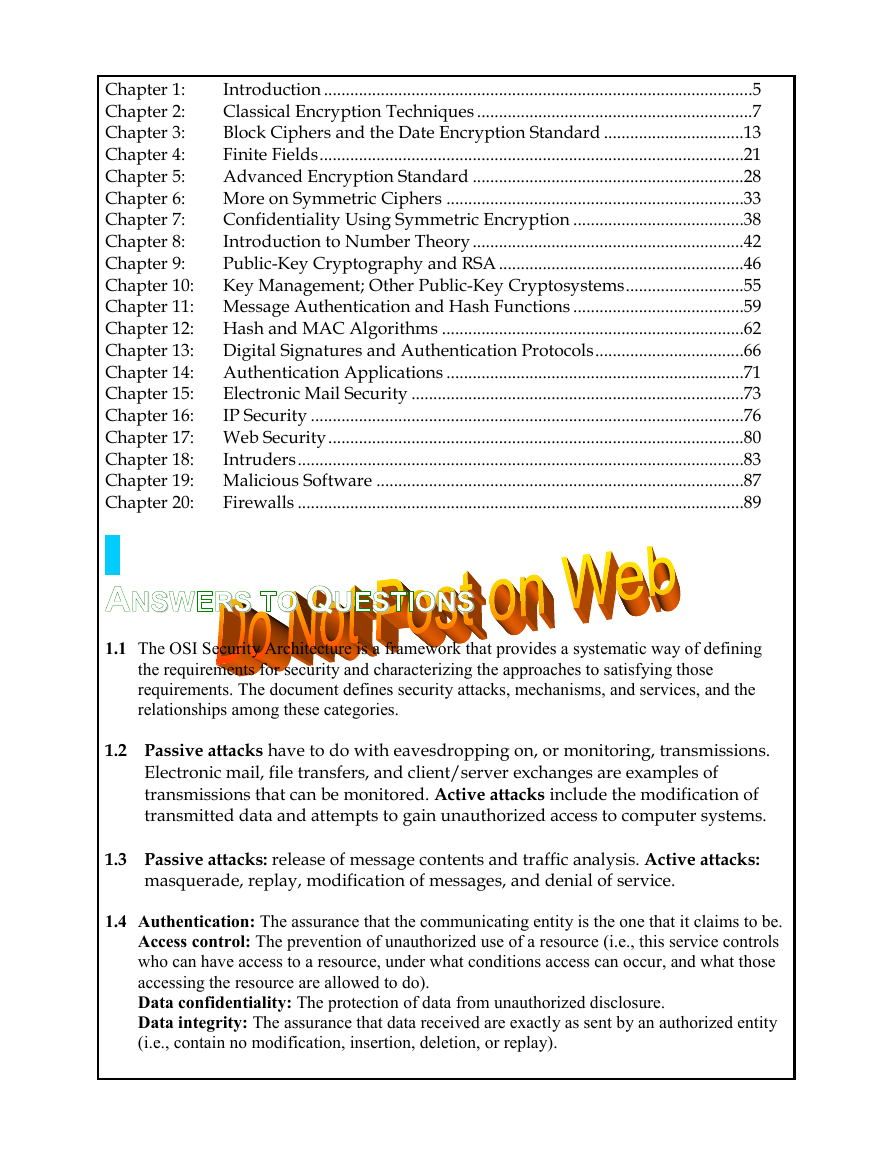
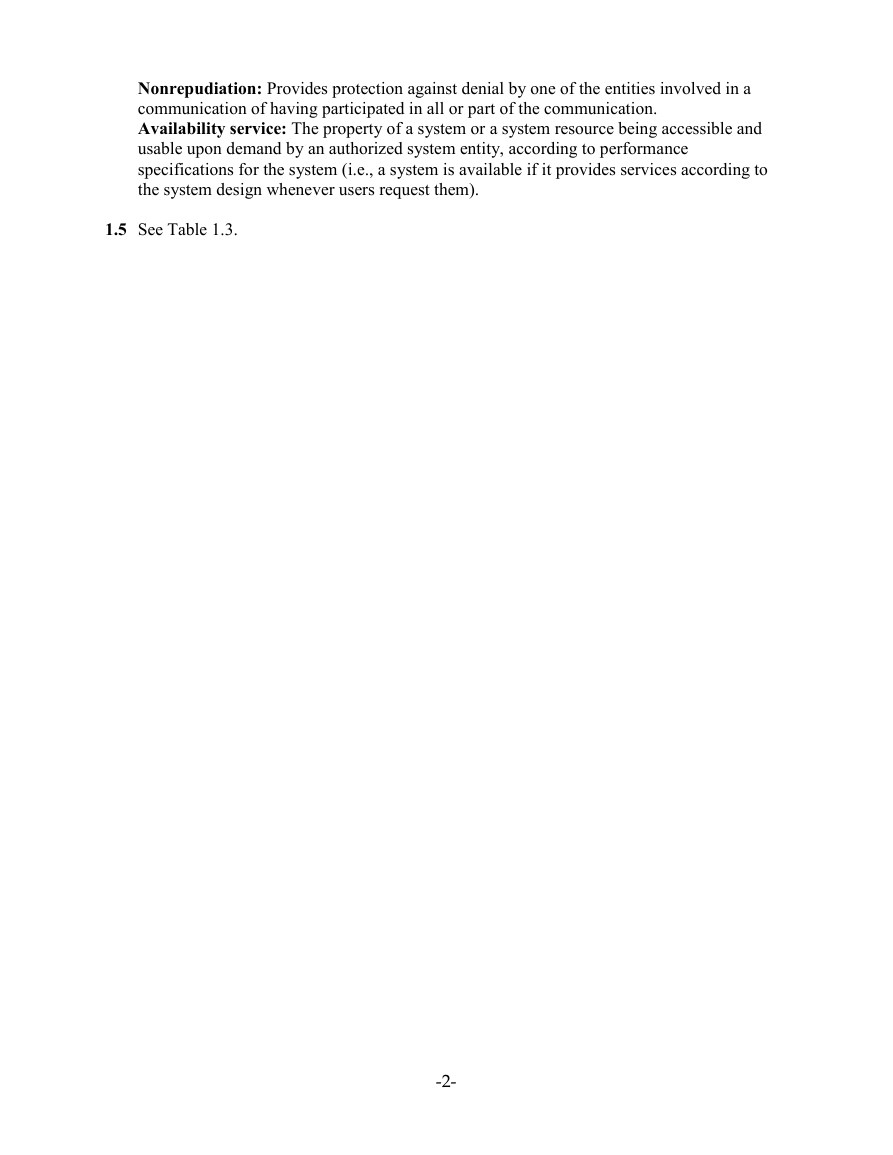
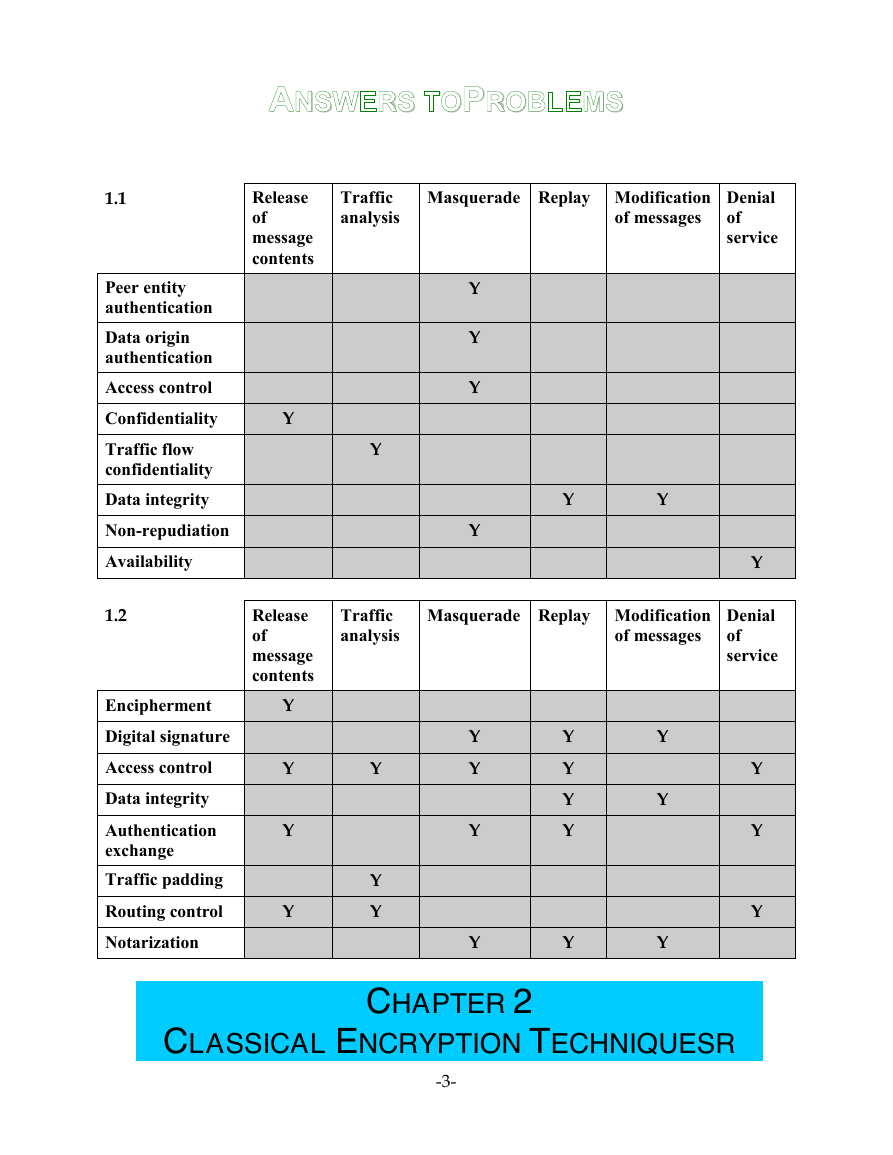



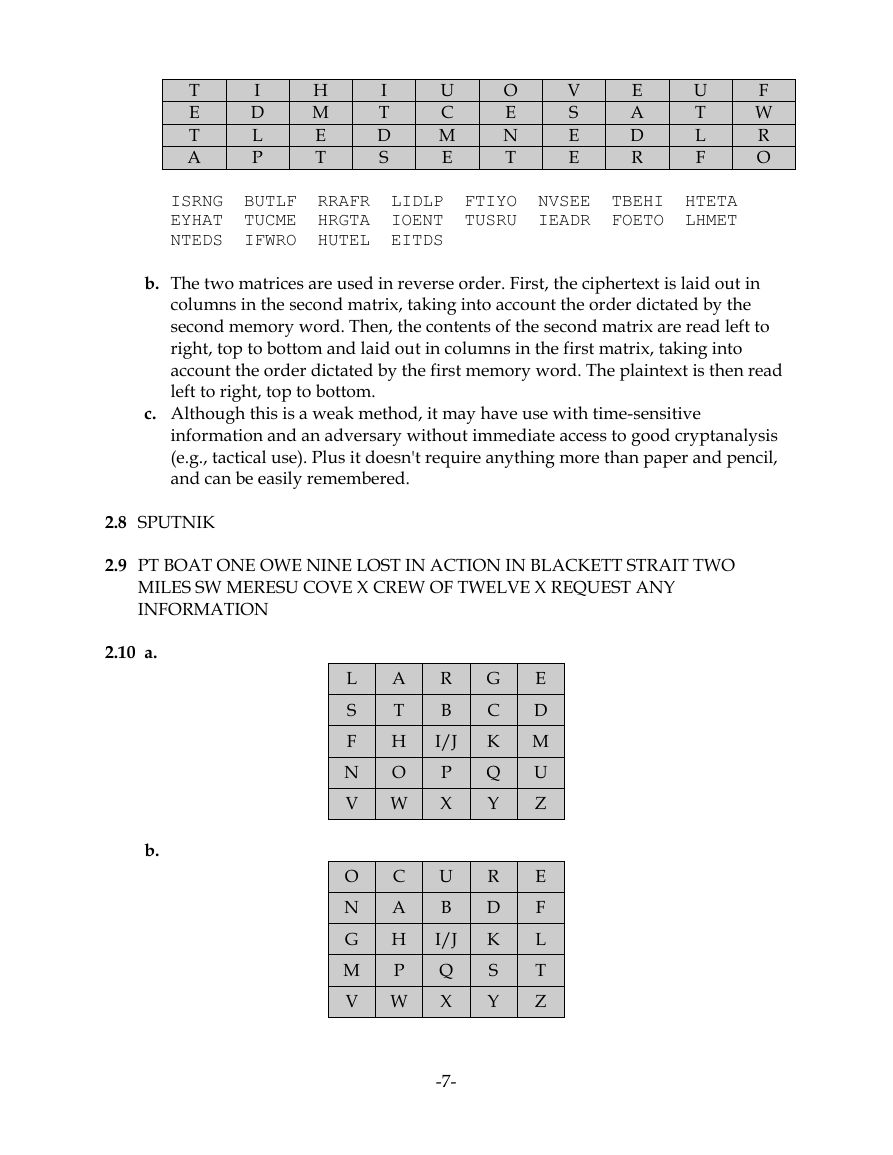
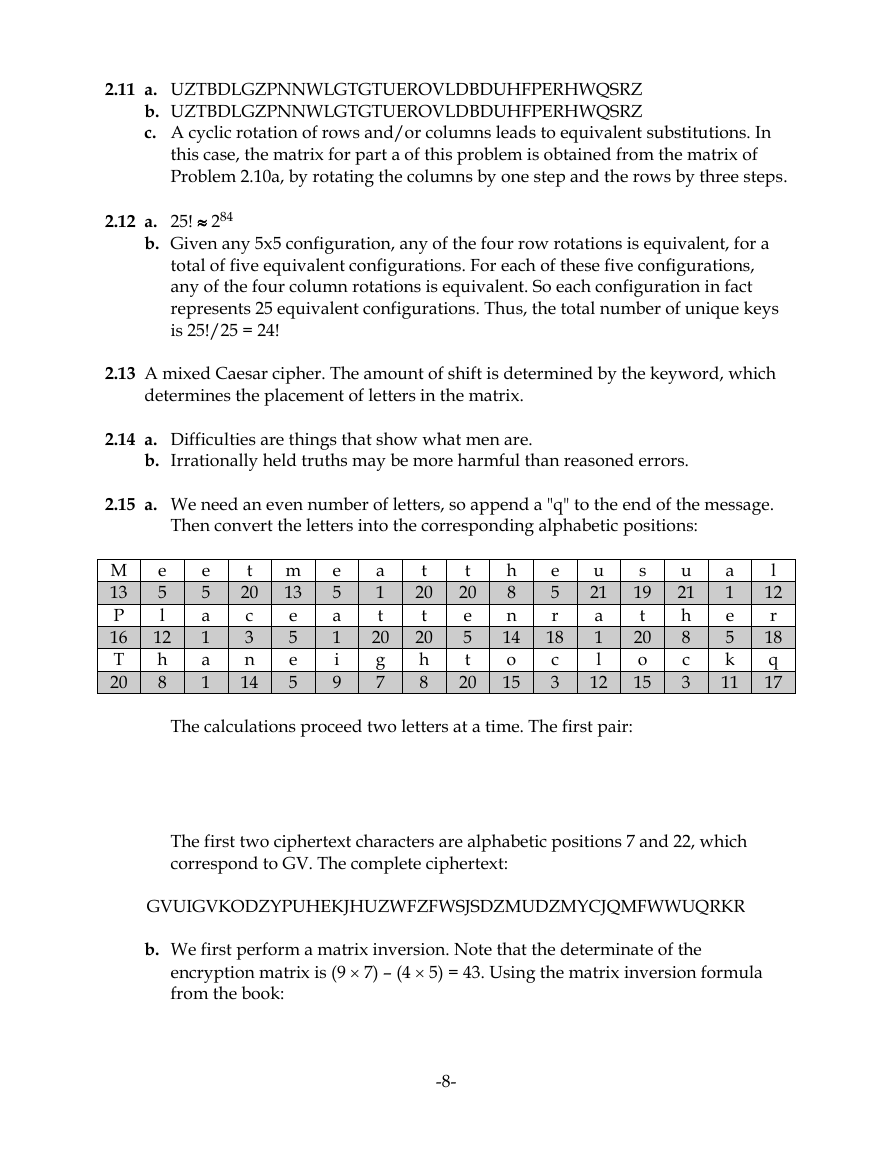








 2023年江西萍乡中考道德与法治真题及答案.doc
2023年江西萍乡中考道德与法治真题及答案.doc 2012年重庆南川中考生物真题及答案.doc
2012年重庆南川中考生物真题及答案.doc 2013年江西师范大学地理学综合及文艺理论基础考研真题.doc
2013年江西师范大学地理学综合及文艺理论基础考研真题.doc 2020年四川甘孜小升初语文真题及答案I卷.doc
2020年四川甘孜小升初语文真题及答案I卷.doc 2020年注册岩土工程师专业基础考试真题及答案.doc
2020年注册岩土工程师专业基础考试真题及答案.doc 2023-2024学年福建省厦门市九年级上学期数学月考试题及答案.doc
2023-2024学年福建省厦门市九年级上学期数学月考试题及答案.doc 2021-2022学年辽宁省沈阳市大东区九年级上学期语文期末试题及答案.doc
2021-2022学年辽宁省沈阳市大东区九年级上学期语文期末试题及答案.doc 2022-2023学年北京东城区初三第一学期物理期末试卷及答案.doc
2022-2023学年北京东城区初三第一学期物理期末试卷及答案.doc 2018上半年江西教师资格初中地理学科知识与教学能力真题及答案.doc
2018上半年江西教师资格初中地理学科知识与教学能力真题及答案.doc 2012年河北国家公务员申论考试真题及答案-省级.doc
2012年河北国家公务员申论考试真题及答案-省级.doc 2020-2021学年江苏省扬州市江都区邵樊片九年级上学期数学第一次质量检测试题及答案.doc
2020-2021学年江苏省扬州市江都区邵樊片九年级上学期数学第一次质量检测试题及答案.doc 2022下半年黑龙江教师资格证中学综合素质真题及答案.doc
2022下半年黑龙江教师资格证中学综合素质真题及答案.doc